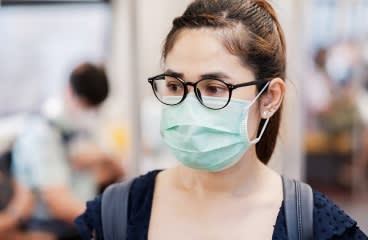Making It Easier to Wear a Mask to Help Prevent Infections
Overview

Why is it important to
wear a mask?
Wearing a mask can be a little uncomfortable at times. Most people would probably agree that it takes some getting used to. But wearing a mask is a way to help keep yourself, your family, and others around you from getting sick.
You may have heard conflicting advice about masks, so it's important to know the facts.
Facts about masks and infections
- Wearing a mask helps control the spread of infections.
Wearing a mask, along with things like washing your hands a lot, is one of the best ways to help prevent the spread of infections like the flu and COVID-19.
- You can have an infection but not have any symptoms.
If this happens, you could spread the infection without knowing it. Wearing a mask helps protect other people from germs that could make them seriously ill.
- Even healthy people can get very sick from infections.
Anyone, from healthy babies to older people who don't have health problems, can get very sick or die from an infection like the flu or COVID-19. And some people are at higher risk for serious illness. This includes people who have a weakened immune system or a chronic disease like asthma.
- Wearing a mask won't cause breathing problems.
Some people are concerned that wearing a mask could cause breathing problems by raising their carbon dioxide (CO2) levels or lowering their oxygen levels. But studies have shown that this isn't true, even for people who have lung or heart problems. Many people, such as health care workers, have always worn masks for hours a day without any breathing problems.
Tips for making it
easier to wear a mask
Do you wish that wearing a mask could be a little easier and more comfortable? Here are some ideas.
- Find a comfortable style and fit.
- Get a mask that fits well over your mouth and chin, with no gaps. A cloth mask should have at least two layers of breathable, washable fabric. Some masks have a slightly stiffer fabric and a different shape that doesn't press against your mouth.
- If it feels better, wear a mask that fits around your head rather than hooking behind your ears. Or use disposable masks if they feel more comfortable.
- Try using a mask that's a lighter color if you'll be wearing it in hot, sunny weather.
- If you wear glasses, put them over the mask's cloth on your nose to keep them from fogging up. Masks that have a wire you can shape around your nose can also help keep glasses from fogging.
- Have extra masks.
It's important to always have a clean, dry mask available. If your mask gets wet, it makes it harder to breathe. If you have trouble remembering your mask, keep extras in a bag, in your purse, or in the car.
- If your masks are washable, wash them often.
This can keep them from getting dirty and collecting germs. And having a clean mask helps keep your skin clean so it's less likely to get irritated.
- Avoid bad odors.
- Brush your teeth well to keep your breath fresh.
- Avoid using scented lotions or perfumes if they give your mask an odor that bothers you.
- If your mask smells bad, try washing it more often. It might help to avoid using scented detergents or dryer sheets.
- Take breaks.
If you have to wear a mask for long periods, take breaks when you can. It's okay to take off your mask outside, as long as you follow public health guidelines. You might be less likely to drink enough water while wearing your mask for a long time. So make sure you drink enough.
- Prevent skin problems.
- Wash your face daily to help keep your skin from getting itchy or irritated. Dry your face gently. Try not to rub or scratch your face if it does get irritated. And try using a cool cloth if it helps.
- Use a gentle face moisturizer. Apply petroleum jelly to your lips if they're chapped. Some skin medicines can be more irritating if used under a mask, so talk to your doctor if you're having problems. Wearing makeup under a mask can cause problems, so avoid it if your skin is irritated.
- If you use oxygen, use a water-based product instead of petroleum jelly.
Credits
Current as of: April 30, 2024
Current as of: April 30, 2024